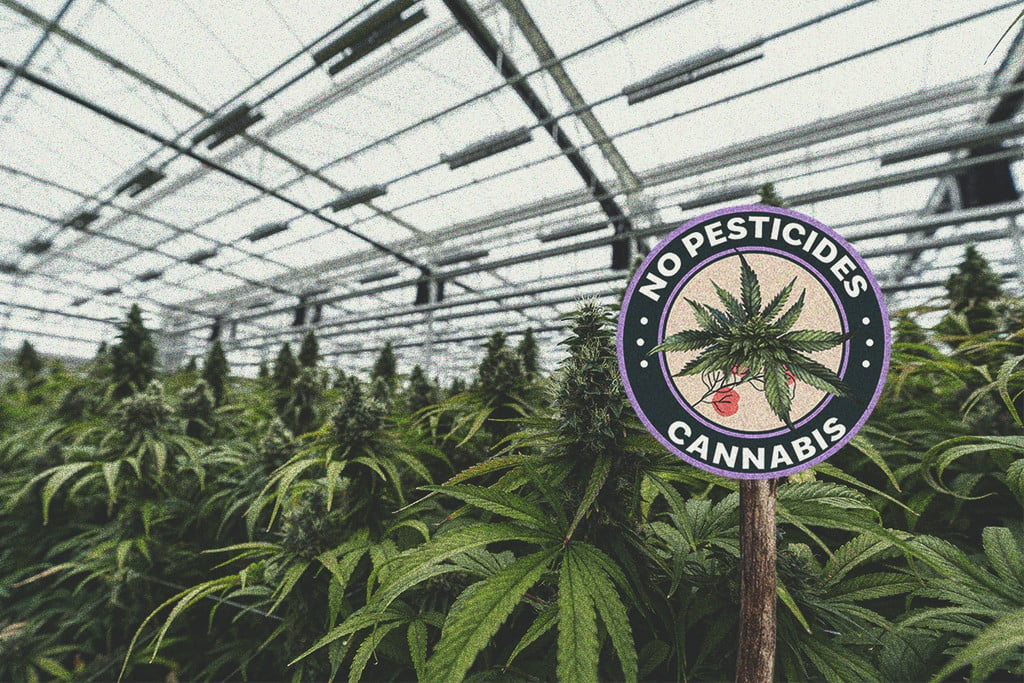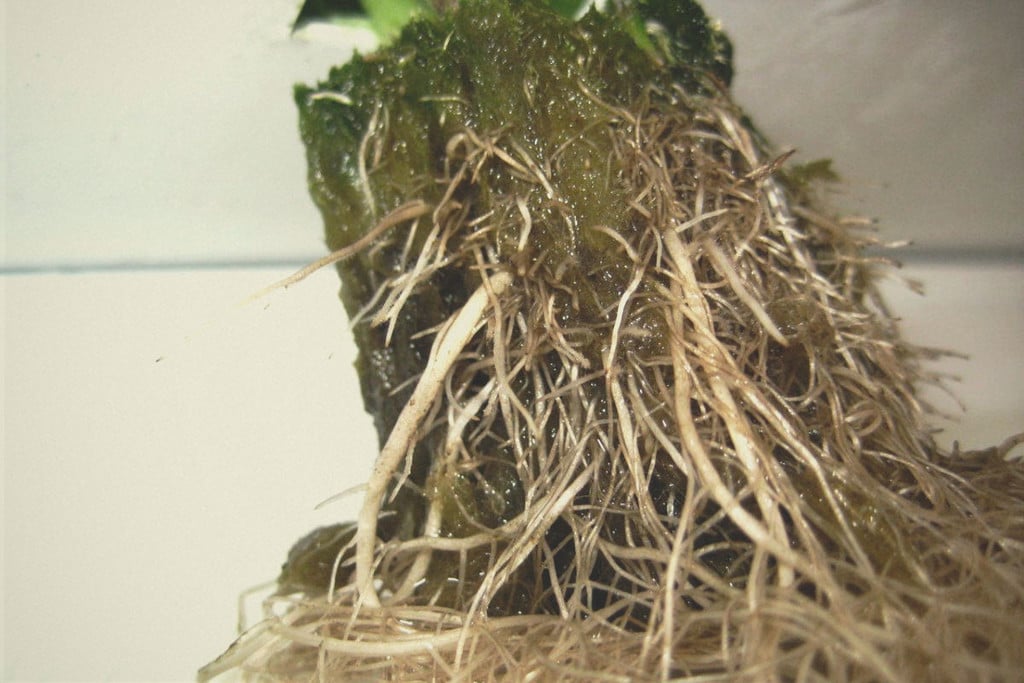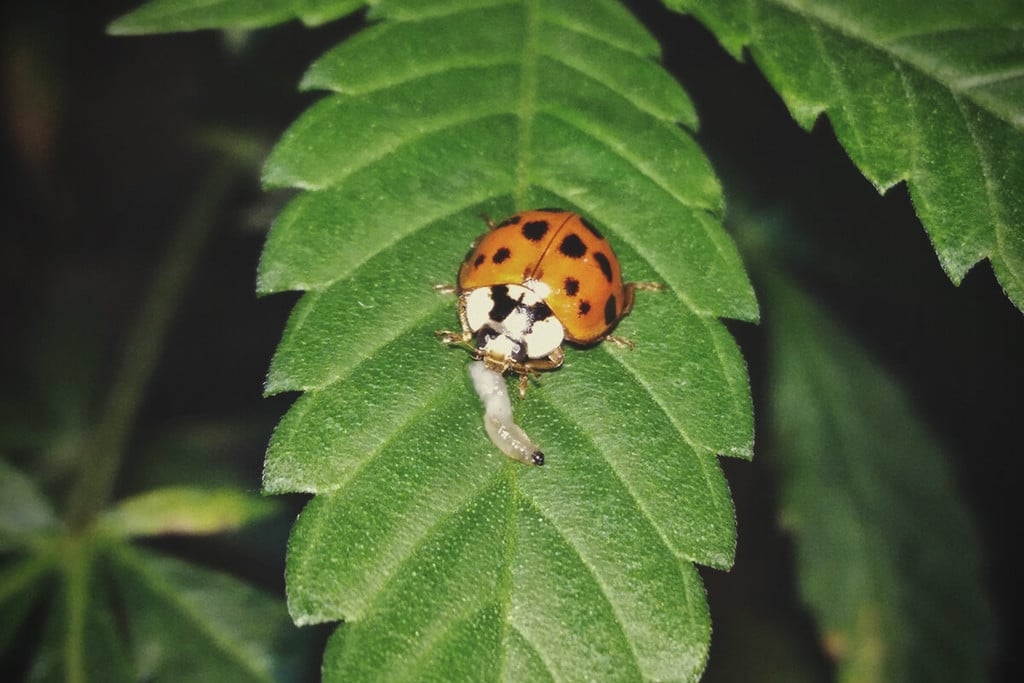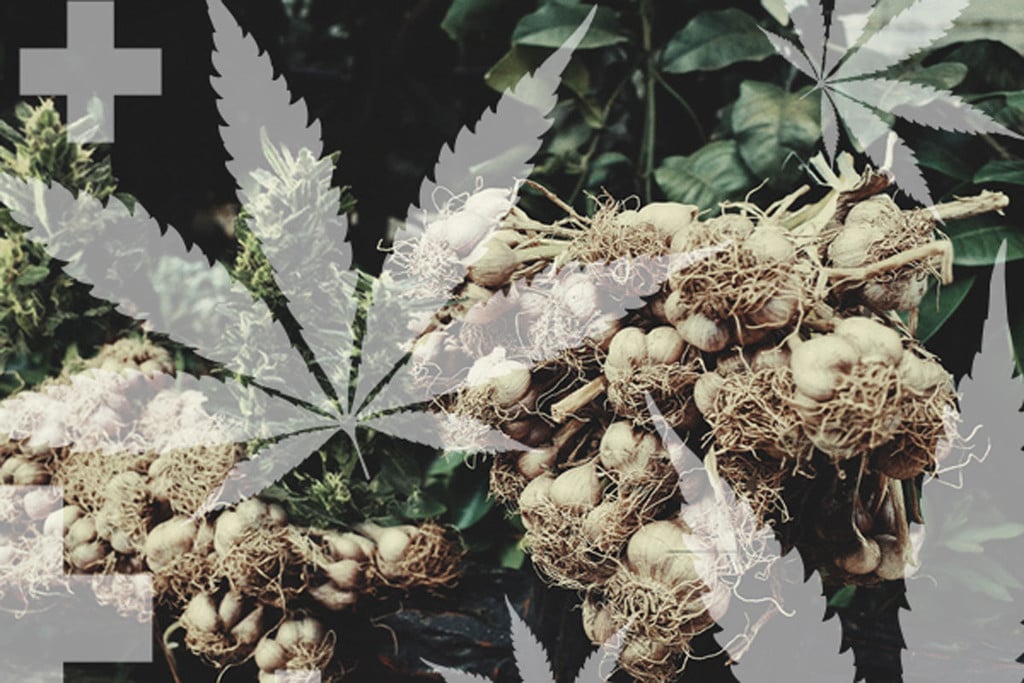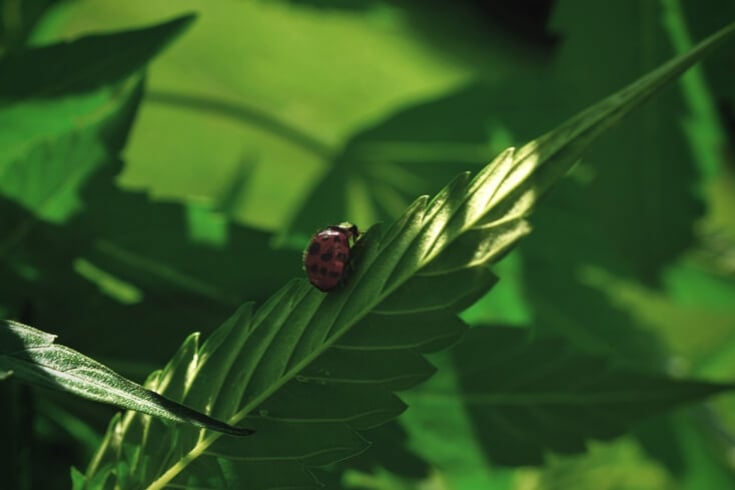.
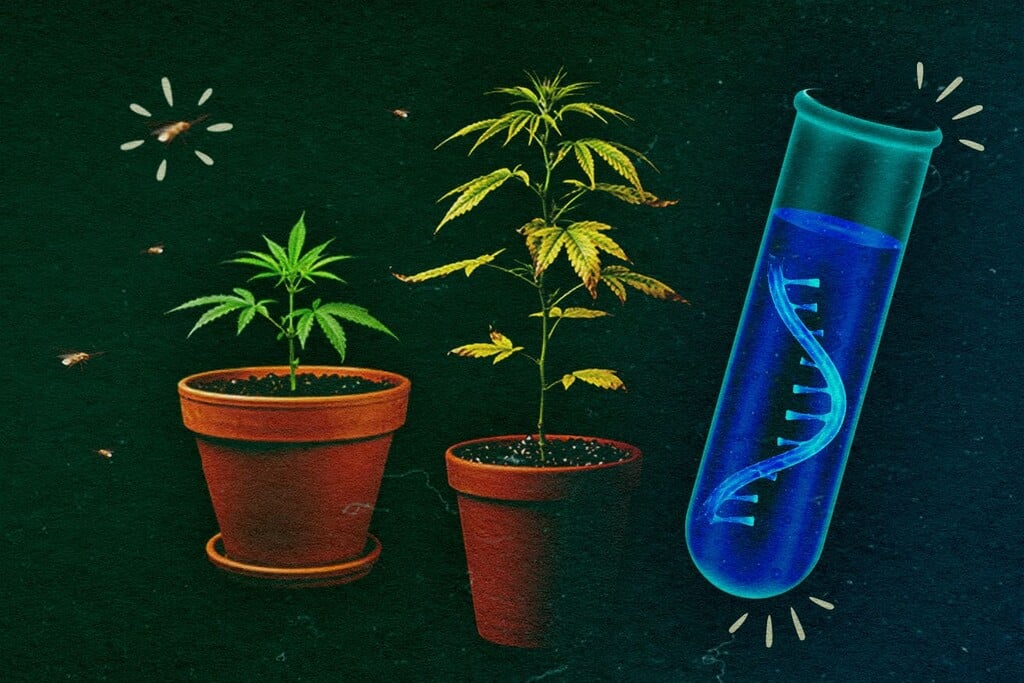
Why Cucurbit Chlorotic Yellow Virus Has Weed Growers Concerned
CCYV can devastate cucurbit crops. And now, researchers have shown that it can infect cannabis, too. Though not an immediate danger, it could become one at any time, and it pays to be one step ahead. In this article, we investigate cucurbit chlorotic yellow virus in cannabis and show you what weed growers can do to prevent it.
Contents:
In 2023, researchers in Israel confirmed[1] that Cannabis sativa can be infected by cucurbit chlorotic yellow virus (CCYV) under controlled conditions. Using whiteflies as a vector, the virus was successfully transmitted to cannabis plants, which then developed chlorotic yellowing and other characteristic symptoms typically seen in infected cucurbits. While this was not a commercial outbreak, the study proved that cannabis is a viable host for CCYV, raising concerns for growers in regions where whitefly pressure is high.
CCYV is not a household name among cannabis producers, but perhaps it should be. Initially a threat to cucurbit vegetables like cucumbers and melons, it has crossed into new host species and now poses a growing danger to commercial cannabis growers. The virus is especially problematic in high-density growing environments, where even a small outbreak can result in large economic losses. Understanding how CCYV infects plants, recognising its symptoms, and adopting proactive strategies, however, can make all the difference.
What is Cucurbit Chlorotic Yellow Virus (CCYV)?
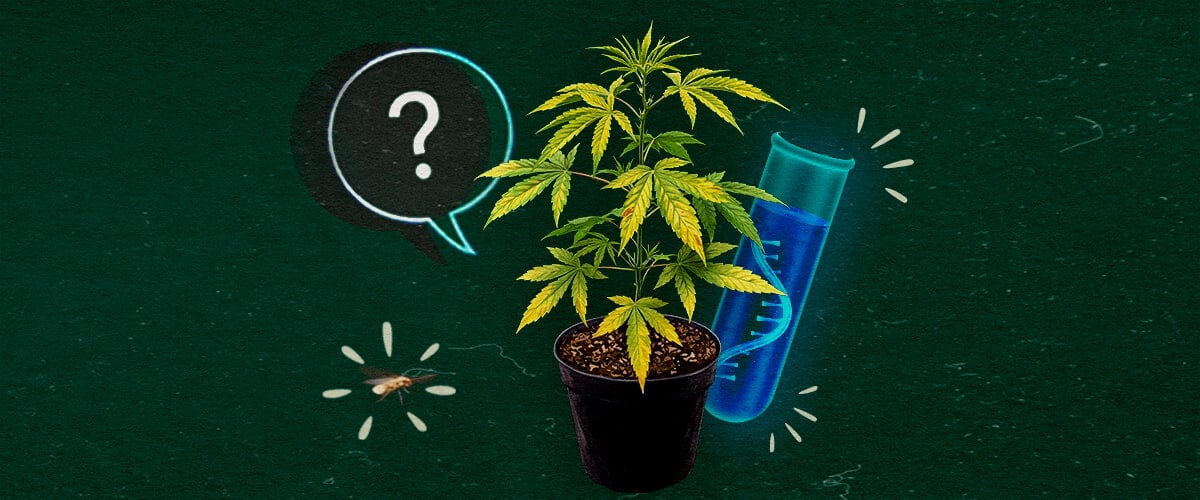
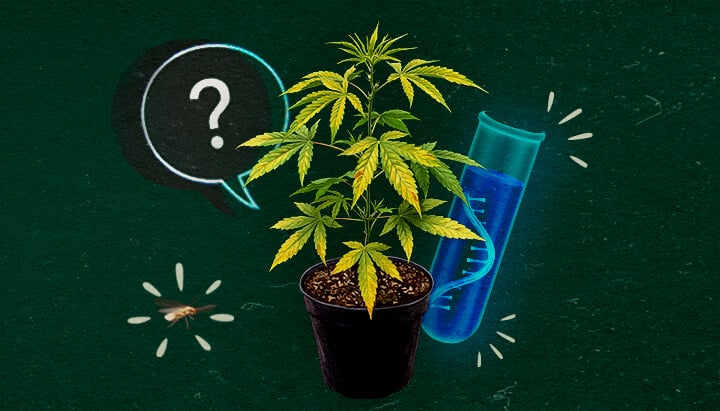
Cucurbit chlorotic yellow virus (CCYV) is a member of the genus Crinivirus in the Closteroviridae family. These are single-stranded, positive-sense RNA viruses known for causing chlorotic disorders in host plants.
CCYV was first described in Japan in the early 2000s after it affected melon crops. It has since been detected across Asia, the Middle East, southern Europe, and the Americas. Although initially limited to cucurbit crops, recent studies have shown that CCYV can infect a broader range of plant species under the right environmental conditions. In cannabis, the presence of CCYV is not widespread, but the potential for rapid expansion exists.
CCYV is particularly insidious because it often evades early detection. Infected plants may appear healthy for several days to weeks before symptoms emerge, during which time the virus can spread via its primary vector—the silverleaf whitefly (Bemisia tabaci).
What makes CCYV particularly dangerous is its adaptation to greenhouse ecosystems, where pest populations can thrive year-round. The virus itself is not mechanically transmitted—instead, it relies entirely on whitefly vectors for movement. Once acquired by the insect, the virus remains within the whitefly’s foregut, from where it can be passed onto new plants during feeding. While not circulative or replicative in these insects, whiteflies can retain the virus long enough for it to efficiently spread across a crop.
Unlike airborne pathogens, CCYV cannot move from plant to plant on its own—it needs a carrier. This dependency gives growers a potential weak point to exploit for control, namely, proper whitefly management.
How CCYV affects weed and cannabis crops
Cannabis is not a traditional host for CCYV, but experimental infection studies now confirm that the plant is susceptible to it under certain conditions. This includes genetic factors, plant stress, and vector exposure. Because cannabis cultivation often involves intensive practices such as cloning and monoculture planting, it creates the ideal conditions for viral proliferation if proper checks are not in place.
CCYV can reduce the vitality of cannabis plants[2] in multiple ways. First and foremost, it interferes with chlorophyll production and distribution, which limits the plant's ability to photosynthesise. This results in slower growth, poor nutrient uptake, and vulnerability to other opportunistic pathogens. In flowering plants, CCYV may also reduce trichome production, affecting both potency and visual appeal.
Symptoms of Cucurbit Chlorotic Yellow Virus
The challenge with CCYV is that its symptoms can mimic several common issues in cannabis, including nitrogen deficiency, overwatering, and heat stress. That means it often goes undiagnosed until whitefly infestations or systemic patterns raise suspicion.
Key symptoms of CCYV in cannabis include:
- Interveinal yellowing (chlorosis): This is the hallmark of CCYV infection. It usually starts on older leaves but can spread rapidly through the canopy.
- Leaf curling and brittleness: Leaves may curl upwards or downwards and become more fragile over time.
- Weakened stems: CCYV can interfere with cell wall development, resulting in stems that are more prone to bending or snapping.
- Flower and bud abnormalities: Affected cannabis plants often produce misshapen, undersized, or underdeveloped flowers with poor resin production.
- Patchy leaf death: Necrotic spots may form on mature leaves in later stages of infection.
- General decline in vigour: Growth slows, branches become sparse, and the plant’s overall development becomes stunted.
CCYV symptoms may develop slowly at first, particularly in cool or low-light conditions. However, once the infection takes hold, there is nothing that can be done to counter it.
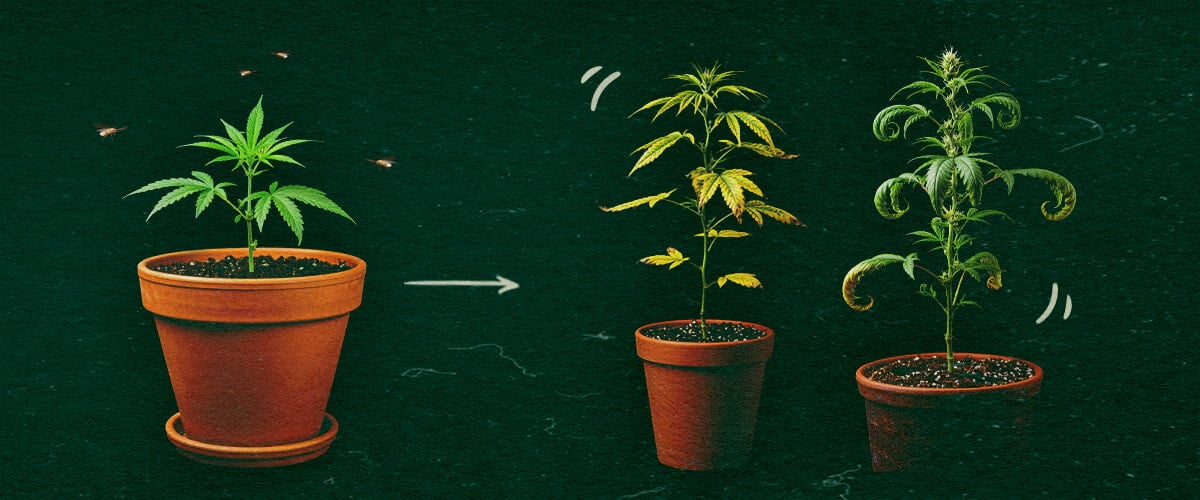
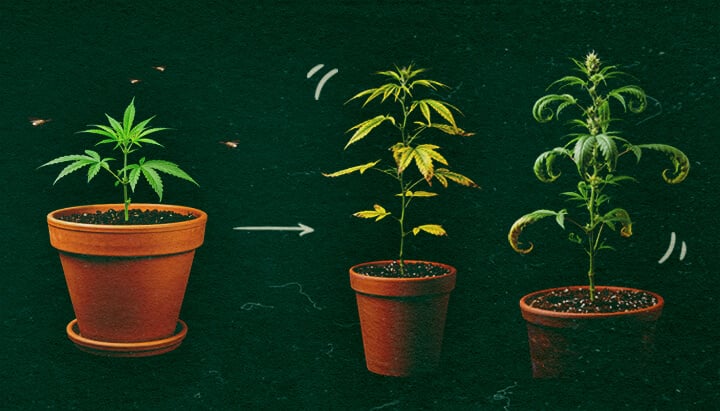
How CCYV spreads among cannabis crops
The spread of CCYV is directly tied to the behaviour of the whitefly—a common cannabis pest that poses many threats to a healthy cannabis crop, including:
- Virus acquisition and retention: A whitefly needs only 30–60 minutes of feeding on an infected plant to acquire the CCYV virus. Once acquired, the virus remains in the insect’s foregut for up to 48 hours—plenty of time to infect multiple plants.
- Rapid population growth: Under optimal conditions (25–30 °C with moderate humidity), whitefly populations can double every 5-7 days.
- Limited natural control indoors: Without natural predators such as ladybirds or parasitic wasps, indoor environments can easily become breeding grounds for unchecked whitefly colonies.
- High mobility: Whiteflies can travel several metres per day, especially if disturbed. This allows them to move quickly through grow spaces and spread diseases to multiple plants.
Note that CCYV is not seed-borne and cannot spread through pollen or leaf contact. However, human activity can indirectly aid its transmission. Contaminated gloves or tools that came into contact with an infected plant’s sap, for example, can transmit the virus to.
Moreover, infected clones can transmit the virus, especially when moved around or between facilities. Interacting with infected cucurbits nearby can also increase the risk of spreading the virus to your cannabis crop.
Environmental conditions also play a major role in the spread of CCYV. High humidity and poor ventilation both favour the reproduction of whiteflies and the stability of the virus. Once a few whiteflies enter a grow room, they can potentially spread CCYV to every plant within reach very quickly.
The economic and agricultural impact on weed growers


For commercial cannabis cultivators, CCYV could become a serious problem. Growers often operate on tight margins and under strict regulatory oversight. A viral outbreak can compromise product quality, delay harvest timelines, and lead to the destruction of an entire harvest.
The key economic impacts of CCYV on cannabis include:
- Loss of yield: Studies show that CCYV can reduce total plant biomass by up to 50% in affected cucurbits. Early reports in cannabis suggest a similar figure, particularly in larger operations where virus or pest containment is delayed.
- Reduced THC and terpene levels: Flowering cannabis plants infected with CCYV may produce less resin, resulting in a final product with fewer cannabinoids and terpenes and, consequently, of considerably lower value.
- Diagnostic and containment costs: Identifying CCYV often requires lab testing, which can be costly, especially if used to screen multiple plants.
- Pesticide and biological control costs: Frequently spraying plants or releasing beneficial whitefly predators into a grow space can raise operational costs and reduce profitability while damaging the local environment.
- Reputational damage: Poor-quality buds that reach consumers can undermine brand trust and lead to a drop in future orders or dispensary contracts.
How to prevent and manage CCYV in weed crops


CCYV can’t be cured—so a cannabis grower’s best offence against it are preventative strategies, as well as the efficient treatment of infected plants to help minimise any further spread of the virus.
The goal when preventing CCYV in cannabis is to remove infected plant material, control vectors, and strengthen prevention moving forward. Prevention, in particular, needs to be a layered process that combines mechanical, chemical, and biological methods.
CCYV prevention strategies
Effective CCYV prevention begins before planting and continues throughout the crop cycle:
- Start with clean stock: Always source clones or seeds from trusted, certified suppliers. Avoid acquiring plants from operations that grow both cannabis and vegetables unless they maintain strict separation protocols.
- Isolate and observe new plants: Quarantine all new arrivals for 10–14 days in a separate space. Monitor for whiteflies or unusual leaf discolouration.
- Disinfect tools and surfaces: Use bleach or hydrogen peroxide solutions to sterilise trimming scissors, and irrigation equipment between uses. Replace disposable gloves regularly.
- Seal your environment: Ensure that vents are screened with 150-micron mesh or finer. Use positive air pressure to prevent outdoor insects from being drawn into your grow space.
- Install airlocks and sticky barriers: Antechambers or airlocks between rooms reduce the chance of pest movement. Sticky mats and adhesive panels can help trap whiteflies before they reach plants.
- Avoid planting cannabis near cucurbits: When growing outdoors or in polyculture settings, avoid placing cannabis near squash, cucumber, or melon plants that can harbour CCYV or attract whiteflies.
- Introduce natural predators: Use beneficial insects such as ladybirds (ladybugs) to help control early whitefly populations. These predators can reduce the need for chemical treatments and support long-term biological control.
Routine hygiene practices can also minimise the introduction of whiteflies into your cannabis growing space. Remember to:
- Use separate uniforms for each growing room or disinfection processes before entry.
- Implement pest scouting logs with routine leaf inspections.
- Schedule weekly whitefly monitoring into your operation.
- Rotate biological controls (predators, parasitoids) to prevent resistance.
Treatment options for CCYV-infected cannabis plants
Once CCYV is detected, act quickly. Your treatment plan should focus on removing infected material and eliminating vector populations safely and quickly.
- Remove symptomatic plants: Pull up and seal infected plants in heavy-duty bags. Burn them if local laws allow it, otherwise dispose of them in sealed bins. Alternatively, move infected plants to an isolated grow space and push them to harvest to cut your losses. Never compost plants that you expect have been infected with CCYV or any other pest/pathogen.
- Apply targeted insecticides: Insect growth regulators (IGRs) and horticultural oils can suppress whiteflies.
- Deploy biological controls: Encarsia formosa and Eretmocerus eremicus, for example, are predatory wasp species that are extremely effective at managing whiteflies.
- Use reflective mulches: In greenhouses and outdoor beds, silver or UV-reflective mulches can deter whiteflies.
- Apply UV-blocking films: Covering greenhouse windows with UV-absorbing plastics reduces whitefly navigation and viral spread.
In heavily-infested rooms, it may be worth halting operations and performing a complete cleanout:
- Remove all plant material and organic waste.
- Fog the space with insecticidal agents.
- Clean all surfaces, ducts, and tools.
- Allow downtime between your next growing cycle for any remaining vector populations to collapse.
The role of whiteflies in CCYV transmission
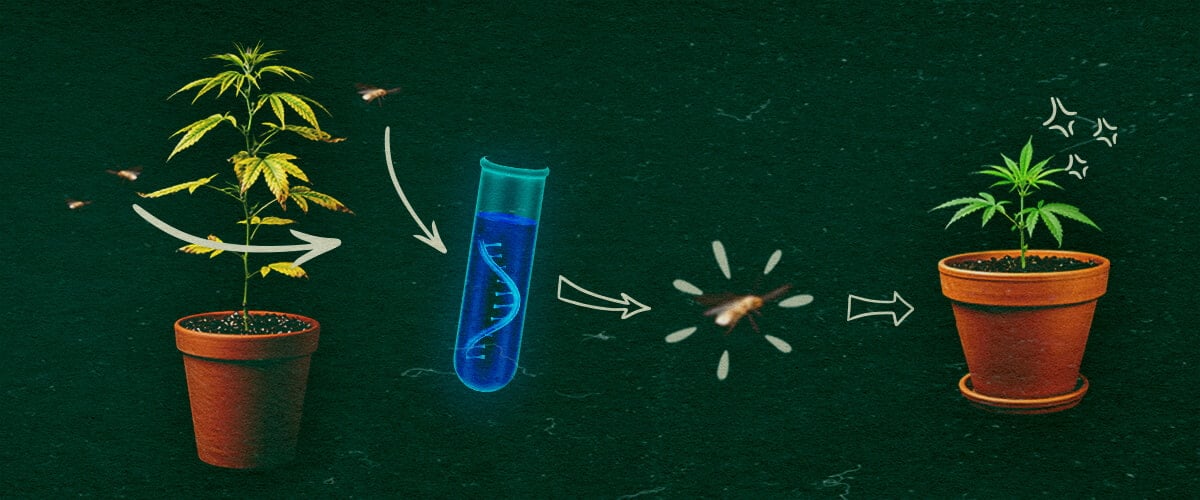
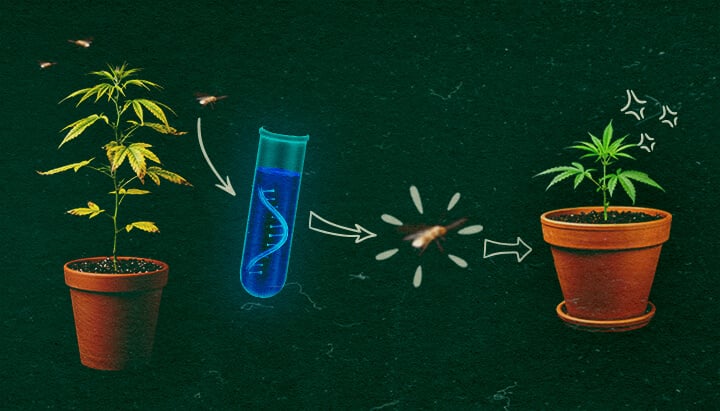
Whiteflies are essential to the transmission of CCYV. Their biology makes them uniquely effective at spreading the virus:
- Feeding behaviour: Whiteflies feed by piercing leaf tissue and sucking out sap. During this process, they can introduce CCYV from their foregut into plant phloem.
- Fast reproductive rate and growth: A single female whitefly can lay over 300 eggs in her lifetime, usually on the underside of leaves. Whitefly eggs can develop into adult flies in just 18 days.
- Host range: Whiteflies feed on hundreds of plant species, including many weeds, making them extremely hard to control —especially outdoors.
To effectively disrupt CCYV transmission, whitefly control must be constant and proactive. Be sure to:
- Monitor egg and nymph stages, not just adults.
- Use entomopathogenic fungi such as Isaria fumosorosea and Beauveria bassiana to prevent larvae growth.
- Avoid using broad-spectrum insecticides that kill beneficial insects.
- Use sticky traps to gauge population trends—not as a standalone control.
- Implement netting and double-door systems in greenhouses.
The sooner whiteflies are identified and controlled, the less chance CCYV has to establish itself in your cannabis garden.
Future outlook: Will CCYV continue to threaten weed cultivation?
Given the global spread of CCYV and increasing cannabis legalisation, it is highly likely that this virus will become a more prominent threat to cannabis grows. Climate trends also favour longer whitefly activity windows, particularly in temperate regions. Finally, increases in protected cropping systems mean that more environments can become conducive to year-round insect pressure.
Luckily, emerging solutions offer some hope against CCYV transmission in cannabis grows. First and foremost, cannabis breeders are consistently producing cultivars with increased resistance to viral pathogens. Moreover, AI and automation promise to revolutionise pest management. As cannabis becomes a global commodity, stricter controls are also being put in place to restrict plant movement and cultivation standards, which may minimise CCYV infestations. Finally, advanced agricultural testing may also allow for faster detection of viral RNA in crops, including cannabis.
For now, CCYV is a known threat with no magic bullet. Fortunately, while the virus has been shown to be able to infect cannabis, it hasn’t yet done so naturally, meaning it’s not a pressing problem. However, it could soon become one, so vigilance and knowledge are crucial for protecting your crop.


























